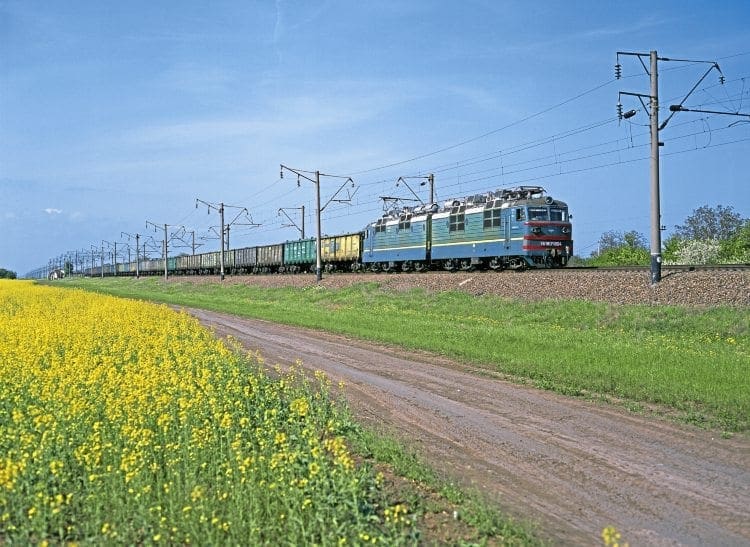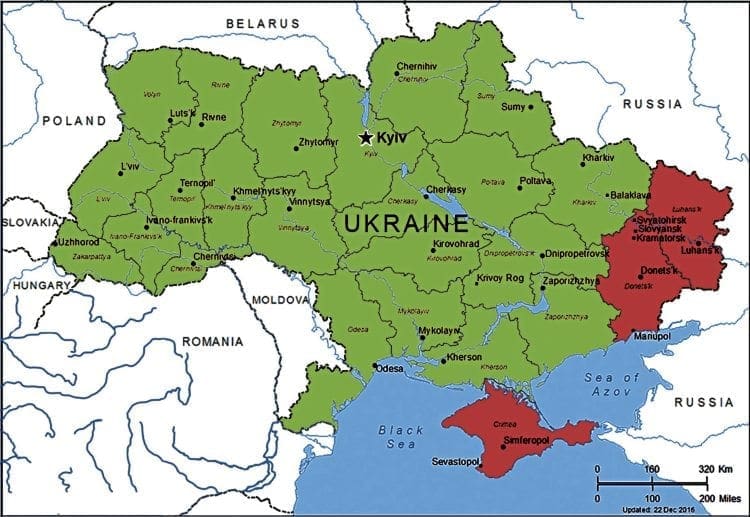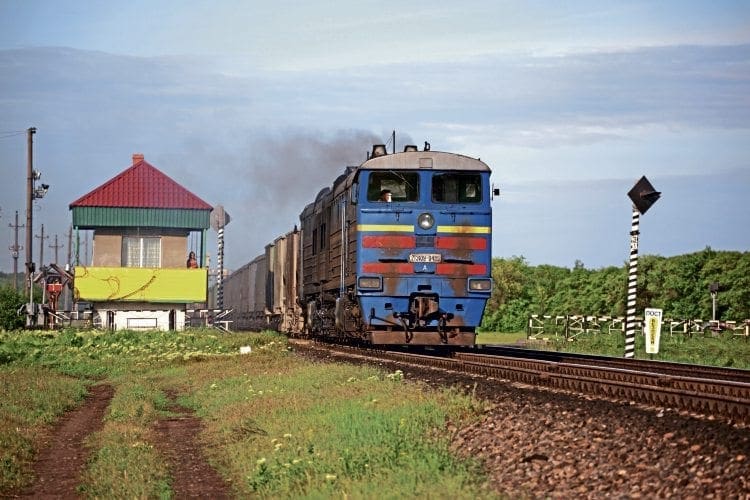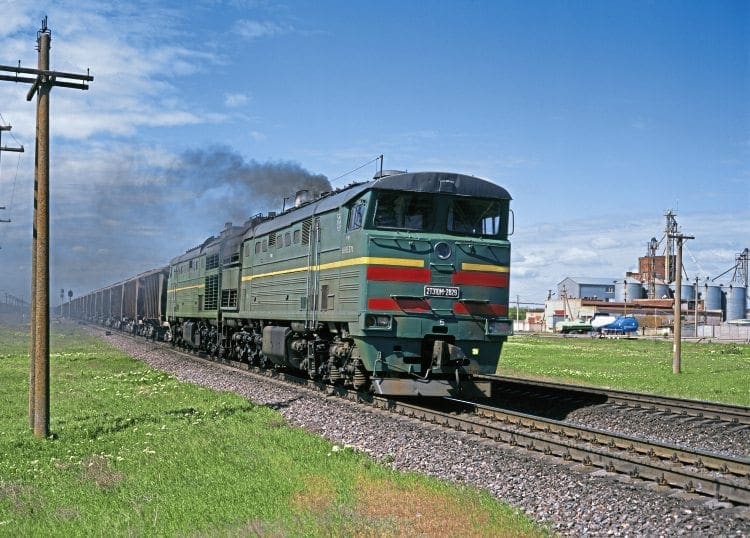
Mark Darby takes a trip to the former Soviet country of Ukraine – an adventure which presented him with more than a few problems, including the discovery he’d been under surveillance for days… as a suspected terrorist!
Railway photography in countries hidden away within the shadows of the former Iron Curtain is, at times, delightful or frustrating in equal measures.
Local citizens wander freely over running lines, as passengers ignore station footbridges. However, without question, visitors are studied and observed; when the authorities have sufficient inclination, detention swiftly follows.
Monthly Subscription: Enjoy more Railway Magazine reading each month with free delivery to you door, and access to over 100 years in the archive, all for just £5.35 per month.
Click here to subscribe & save
Mykolaiv, in southern Ukraine, holds no bias towards tourism, being mainly of strategic importance, with large shipbuilding yards, situated next to the Gulf of Dniprovs’ka and the Black Sea. Mykolaiv is also a busy stamping ground for diesel locomotive type 10, commonly referred to as TEP10s or ‘Earthquakes’.
These 5,480hp, semi-permanently coupled, single-cabbed, twin-unit locomotives would be the main reason for me to visit (with two German enthusiasts) this interesting backwater, close to the border with Crimea, which is currently one of Russia’s ‘irritations’.
To Kiev and Tiraspol

The theme for the trip appeared to be set at passport control of Dortmund Airport, as a German official questioned my lack of visa for a visit to Ukraine, which as a citizen of the UK would apparently be required. Pre-trip, the UK Government’s Foreign & Commonwealth Office website confirmed visas were not necessary for Ukraine – and indeed Transnistria, our joint proposed destinations. Tiraspol in Transnistria, however, would be another story!
A midnight arrival at Zhulyany airport, Kiev, required efforts akin to a ‘bribe’ in order to secure a city-bound taxi, as all taxis amazingly were pre-booked, apparently a recently introduced piece of tourist-unfriendly bureaucracy.
Sunday, May 7 offered opportunities for morning photography beneath cloudless 30 degree skies around Kiev. Our home-spun itinerary included a visit to the children’s railway situated within Syretsky Park. The children’s railway is entirely run by apprentice adults aged between 11 and 16, who drive the trains, work the signals and staff the entire 750mm narrow gauge system, with very minimal supervision; a superb, popular Soviet idea for the leisure time of juniors, an excellent idea to replicate perhaps?
The visit to Syretsky Park would be followed by a late-afternoon departure from Pasazhyrskyi, for a seven-and-a-half-hour journey with Skoda ‘Chs8’ haulage to Odessa.
For the second consecutive day, our destination would be reached beyond midnight.
Having endured a night in a hotel room with a couple of slightly sinister occupants of the cockroach-based variety, ‘rental car day’ subsequently dawned. With a set of ‘wheels’ in our possession, scenic lineside photographic positions became accessible. The vehicle would also be necessary as two thirds of the party intended to visit Transnistria for railway photography, along with a proposed attendance of Victory Day military parades on May 9.

Machine gun
A collection of Ladas and Moskvitchs, dodging the multitude of potholes that constituted much of Ukraine’s road system, certainly made for an enthralling driving experience.
Once deposited at Odessa Central bus station, our woes became increasingly evident, as the 17.35 service to the Transnistrian border and Tiraspol – for which our tickets were valid – had been cancelled (the omni-present language barrier again was the precursor of problems during attempts to
re-book).
With substitute tickets eventually sorted, the driver of the following service to Tiraspol belligerently made it obvious that entry to his dilapidated mini-bus would not happen, despite the fact an old fridge was bound with skinny shards of rope to two adjoining front seats!
Given the lack of spoken English outside of Kiev, a middle-aged female shouted from behind the aforementioned lump of white goods: “Why don’t you ******* walk, it’s only one hundred kilometres,” – the noisy rebuke duly attracting attention from an armed guard. Military personnel also appeared frequently around many transport hubs.
Regardless of the fact our paperwork confirmed all necessary stipulations required to enter Transnistria were in order, when the barrel of a machine gun gestures movement in a particular direction, that direction is taken, even if it is not the one of choice.
The militia character appeared forcible, but not so agitated as the bus driver. With our bus tickets re-translated via the internet, they were correct. As German and English ‘foreigners’ we concluded the driver had re-appropriated our seats for his own gain.
Having contacted our Transnistria guide by e-mail regarding our non-appearance, our Android friend again became indispensable, exercising various accommodation sites within the all-encompassing WWW (world wide web), in order to procure replacement beds, where thankfully no internet language barrier existed.
As a point of note, it may be of interest that stipulations for entry into Transnistria by road from Ukraine require a pre-booked guide to accompany from the border, along with accommodation confirmation. Arrival at the internationally un-recognised crossing point, and paperwork would be issued, requiring exit visa application within 48 hours of arrival. This procedure is not possible to formalise from within the UK.
Despite the disappointing failure to enter Transnistria, Mykolaiv, along with its fleet of ‘Earthquakes,’ invitingly beckoned.
Rozdil’na-1, junction for the branch to Tiraspol, situated on the Kiev to Odessa main line, witnesses plenty of traffic. Little is bound for Transnistria and Moldova, however a through Moscow service featured in the 2017 timetable.
While occupying the legal side of the dropped level crossing barriers, south of the station, in order to photograph southbound traffic, confrontation again took place, as the crossing keeper hurled abuse in our direction. The railway employee emphasised his annoyance by visibly noting down the registration number of our rented white Dacia.

Umbrage
Apparently situated within a ‘restricted’ zone, Mykolaiv hosts few tourists. Arrival across the lengthy Varvarivskyi Bridge, spanning the southern Bug river, portraying many inviting picturesque waterside hostelries, indicated views to the contrary. Contained within the structure of the bridge is ‘Europe’s’ longest swing platform.
Unfortunately, for the second consecutive day, umbrage would again be extended in our direction. However, after the crossing keeper had made clear our presence was ‘verboten’, impressions became slightly downbeat, as it appeared even though no further trains were due, the crossing barriers failed to rise, effectively preventing our vehicle returning to the main traffic flow. Seemingly, an age followed, until the barriers began to lift, finally allowing escape.
Having discussed our previously perceived crossing box incarceration with slight irony, events soon became far more apparent. After photographing next to the crossing box, south of the main station, a ‘heritage’ Lada Riva, driven erratically in our direction, on the wrong side of the highway, almost forced a spot of off-roading.
Laughingly, this manoeuvre would be passed off as typical of Ukrainian road skills. Mirth didn’t last for too long, however. Upon parking in a marked bay at Mykolaiv Main station, the previously evaded Lada rapidly slid into a blocking position behind our car. Immediately, the two rather animated occupants encroached our personal space, shouting and gesticulating in their mother tongue. Our assumption was they were not happy.
Without a uniform between them, who were they, and what possibly could be their problem? Despite not understanding the local parlance, we had our suspicions, given the less than amicable reception received thus far from the railway people.
With verbal ability to communicate at a complete minimum, one of the Lada boys began broadcasting from his classic car’s ancient citizens band-style radio equipment. Given the ongoing stand-off, there was no surprise at the arrival of a marked Politsiya Toyota Prius; contained within, a couple of ‘real’ police officers. The non-conversation continued, with further gesticulations and ‘verbals’.
Sombre
With onlookers gathering, mobile phone conversations continued among the Ukrainian officials. The arrival of a second marked police car, and seemingly the authorities, meant they had upped their game, as the officer, a lieutenant, had a perfect command of English.
“Passports please,” he demanded.
With documents checked, our group was split up; the German contingent accommodated in the first Politsiya car, which arrived on the scene, while the British contingent went in the car containing the English speaking officer.
At this point, concerns were seriously aroused, as an explanation followed thus: that over a period of two days, our party had been observed ‘wearing body packs’ (rucksacks) around strategic railway installations, acting furtively within station confines, and NOT boarding trains, all in a restricted area, close to the Crimean border. At this point, separation added to a fairly sombre mindset.
Once reunited at Mykolaiv city police station, we were informed we had been arrested as suspected terrorists. We were led past some hardcore holding cells up a set of stairs into a room akin to a court. Politeness and cups of tea followed, certainly not how these situations would be portrayed by Hollywood.

Having answered the questions relating to our intended travel plans, specific questioning followed, firstly aimed in my direction.
“Why did you enter Ukraine via Germany, and not directly from the UK?”
“So that I could travel with my friends.”
“How are you friends, how do you identify with each other as you are from different countries?”

“We met in Poland, in 2014, while indulging in railway photography, we were not arrested in Poland.”
Again the question of entry via Germany would be raised.
We were informed further questioning by officials from the Ministry of Internal Affairs would follow shortly. Two men duly arrived, they were stoney faced, and looked like they meant business. It was my arrival via Dortmund, and not directly from the UK, which was their main mantra. They even possessed details of all the railway locations we had visited, none of which we could deny. Was a diplomatic incident about to unravel?
Questioning continued along the lines of why we indulged in the strange ‘occupation’ of railway photography. We responded with “not an occupation, a hobby”, subsequently having to explain how each of us made a living.
Eventually one of the Government people again requested our passports. The official and our paperwork were absent for a considerable amount of time. While the bureaucrat was away, the arresting officer explained that although railway photography was not illegal, the railway employees and indeed the Lada-driving railway police continued to adhere to former communist-based values, and our presence at certain locations appeared to be the stumbling block.
The officer continued that we should not worry, as in his opinion there was no real case to answer and we should not be charged. His thoughts were that the Government official would be corroborating answers and personal histories with our respective security forces in London and Berlin.

‘Should be sent to prison’
Upon the return of our passports, the demeanour of the Government man had changed, becoming slightly jocular. He summarised the situation: we were to be released to continue our photography, however given the problems with Russia in Crimea, and its close proximity, the advice of the Ukrainian Government would be to photograph out of the view of stations, signal and crossing boxes, as the workers were correctly reporting suspicious behaviour.
He added – with a smirk – that he felt for our own sanity, we should be sent to prison for participating in such a strange hobby!
Our detention lasted beyond the departure of the officials as word had leaked out that some strange visitors had been detained, prompting various officers wishing to record ‘selfie’ images with the ‘train’ people.

Our temporary incarceration, from the outset, was handled with complete empathy, the arresting officer, a top official named Bogdan, concisely explaining the custodial procedure, every step of the way. Detention lasted a little more than four hours.
Having received a return lift with Bogdan to be reunited with our rental car, the rest of the trip would be significantly less entertaining.
Mykolaiv is the hub for routes radiating to Odessa, Dolyns’ka, Kherson and the lesser branch line to Snihurivka. The route to Dolyns’ka and ultimately Kiev was understandably the busiest, with electrification imminent. The scenery around Odessa and Mykolaiv is essentially flat with much woodland, overbridges, very much at a premium.
Because of the distances covered by some of the passenger services, many do not run daily, arriving at the destination one or two, or on some occasions several days after originally setting out.
Passenger trains on the Dolyns’ka line were frequently punctuated by freights, with commodities including grain, petro-chemicals, coal and scrap metals, mostly serving the many terminals around Mykolaiv’s expansive harbour network.
Given the excitement of the arrest, only a spot of time for photography remained.
Return to the UK, again via Germany, held comparatively little interest.

As a footnote, arrival home prompted a spot of post-trip research, where Google Earth revealed a huge military airbase situated behind an avenue of trees next to the crossing box, where the Lada first came to our attention.
A more detailed inspection revealed the base to be well stocked with MIG, Sukhoi, and Antonov fighters and ground attack aircraft. Several helicopters were witnessed populating the skies, but these gave no obvious clues as to the magnitude and hardware that lay behind the greenery.




